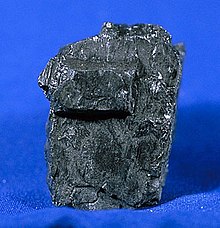Fossil Fuels are formed due to the anaerobic decomposition of organic matter. Plants and animals buried deep down in the earth's crust decompose in the absence of air under high pressure and temperature. The formation takes millions of years to take place.
Fossil Fuels contain high percentage of carbon. The most important of the fossil fuels are Coal, Petroleum and Natural Gas.
It was estimated by the Energy Information Administration that in 2007 primary sources of energy consisted of petroleum 36.0%, coal 27.4%, natural gas 23.0%, amounting to an 86.4% share for fossil fuels in primary energy consumption in the world. Non-fossil sources in 2006 included hydroelectric 6.3%, nuclear 8.5%, and others (geothermal, solar, tide, wind, wood, waste) amounting to 0.9%. World energy consumption was growing about 2.3% per year.
Fossil Fuels are non-renewable sources of energy since they take millions of years to form and can be exhausted quickly.
Coal: Coal is a combustible black or brownish-black sedimentary rock usually occurring in rock strata in layers or veins called coal beds or coal seams. The harder forms, such as anthracite coal, can be regarded as metamorphic rock because of later exposure to elevated temperature and pressure. Coal is composed primarily of carbon along with variable quantities of other elements, chiefly hydrogen, sulfur, oxygen, and nitrogen.
Petroleum: Petroleum (Greek: petra (rock) + Latin: oleum(oil)) or crude oil is a naturally occurring, flammable liquid consisting of a complex mixture of hydrocarbons of various molecular weights and other liquid organic compounds, that are found in geologic formations beneath the Earth's surface. A fossil fuel, it is formed when large quantities of dead organisms, usually zoo plankton and algae, are buried underneath sedimentary rock and undergo intense heat and pressure. Petroleum is recovered mostly through oil drilling. This latter stage comes after the studies of structural geology (at the reservoir scale), sedimentary basin analysis, reservoir characterization (mainly in terms of porosity and permeable structures). It is refined and separated, most easily by boiling point, into a large number of consumer products, from petrol and kerosene to asphalt and chemical reagents used to make plastics and pharmaceuticals. Petroleum is used in manufacturing a wide variety of materials, and it is estimated that the world consumes about 88 million barrels each day. The use of fossil fuels such as petroleum can have a negative impact on Earth's biosphere, releasing pollutants and greenhouse gases into the air and damaging ecosystems through events such as oil spills.
Fossil Fuels contain high percentage of carbon. The most important of the fossil fuels are Coal, Petroleum and Natural Gas.
It was estimated by the Energy Information Administration that in 2007 primary sources of energy consisted of petroleum 36.0%, coal 27.4%, natural gas 23.0%, amounting to an 86.4% share for fossil fuels in primary energy consumption in the world. Non-fossil sources in 2006 included hydroelectric 6.3%, nuclear 8.5%, and others (geothermal, solar, tide, wind, wood, waste) amounting to 0.9%. World energy consumption was growing about 2.3% per year.
Fossil Fuels are non-renewable sources of energy since they take millions of years to form and can be exhausted quickly.
 |
| Coal |
Throughout history, coal has been a useful resource for human consumption. It is primarily burned as a fossil fuel for the production of electricity and/or heat, and is also used for industrial purposes such as refining metals. Coal forms when dead plant matter is converted into peat, which in turn is converted into lignite, then anthracite. This involves biological and geological processes that take place over a long period of time.
 |
| petroleum |
Natural Gas: Natural gas is a naturally occurring hydrocarbon gas mixture consisting primarily of methane, with up to 20 percent concentration of other hydrocarbons (usually ethane) as well as small amounts of impurities such as carbon dioxide. Natural gas is widely used and is an important energy source in many applications including heating buildings, generating electricity, providing heat and power to industry and vehicles and is also a feed stock in the manufacture of products such as fertilizers.
 |
| combustion of natural gas |








0 comments:
Post a Comment